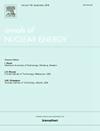Predicting critical heat flux with uncertainty quantification and domain generalization using conditional variational autoencoders and deep neural networks
IF 1.9
3区 工程技术
Q1 NUCLEAR SCIENCE & TECHNOLOGY
引用次数: 0
Abstract
Deep generative models (DGMs) can generate synthetic data samples that closely resemble the original dataset, addressing data scarcity. In this work, we developed a conditional variational autoencoder (CVAE) to augment critical heat flux (CHF) data used for the 2006 Groeneveld lookup table. To compare with traditional methods, a fine-tuned deep neural network (DNN) regression model was evaluated on the same dataset. Both models achieved small mean absolute relative errors, with the CVAE showing more favorable results. Uncertainty quantification (UQ) was performed using repeated CVAE sampling and DNN ensembling. The DNN ensemble improved performance over the baseline, while the CVAE maintained consistent results with less variability and higher confidence. Both models achieved small errors inside and outside the training domain, with slightly larger errors outside. Overall, the CVAE performed better than the DNN in predicting CHF and exhibited better uncertainty behavior.
基于条件变分自编码器和深度神经网络的不确定性量化和领域泛化预测临界热流
深度生成模型(dgm)可以生成与原始数据集非常相似的合成数据样本,解决数据稀缺性问题。在这项工作中,我们开发了一个条件变分自编码器(CVAE)来增加2006年格勒内费尔德查找表中使用的临界热通量(CHF)数据。为了与传统方法进行比较,在同一数据集上评估了一种微调深度神经网络(DNN)回归模型。两种模式的平均绝对相对误差都很小,CVAE的结果更有利。不确定度量化(UQ)采用重复CVAE采样和DNN集成。DNN集成在基线上提高了性能,而CVAE保持了一致的结果,变异性更小,置信度更高。两种模型在训练域内外的误差都很小,训练域外的误差略大。总体而言,CVAE在预测CHF方面优于DNN,并表现出更好的不确定性行为。
本文章由计算机程序翻译,如有差异,请以英文原文为准。
求助全文
约1分钟内获得全文
求助全文
来源期刊

Annals of Nuclear Energy
工程技术-核科学技术
CiteScore
4.30
自引率
21.10%
发文量
632
审稿时长
7.3 months
期刊介绍:
Annals of Nuclear Energy provides an international medium for the communication of original research, ideas and developments in all areas of the field of nuclear energy science and technology. Its scope embraces nuclear fuel reserves, fuel cycles and cost, materials, processing, system and component technology (fission only), design and optimization, direct conversion of nuclear energy sources, environmental control, reactor physics, heat transfer and fluid dynamics, structural analysis, fuel management, future developments, nuclear fuel and safety, nuclear aerosol, neutron physics, computer technology (both software and hardware), risk assessment, radioactive waste disposal and reactor thermal hydraulics. Papers submitted to Annals need to demonstrate a clear link to nuclear power generation/nuclear engineering. Papers which deal with pure nuclear physics, pure health physics, imaging, or attenuation and shielding properties of concretes and various geological materials are not within the scope of the journal. Also, papers that deal with policy or economics are not within the scope of the journal.
 求助内容:
求助内容: 应助结果提醒方式:
应助结果提醒方式:


